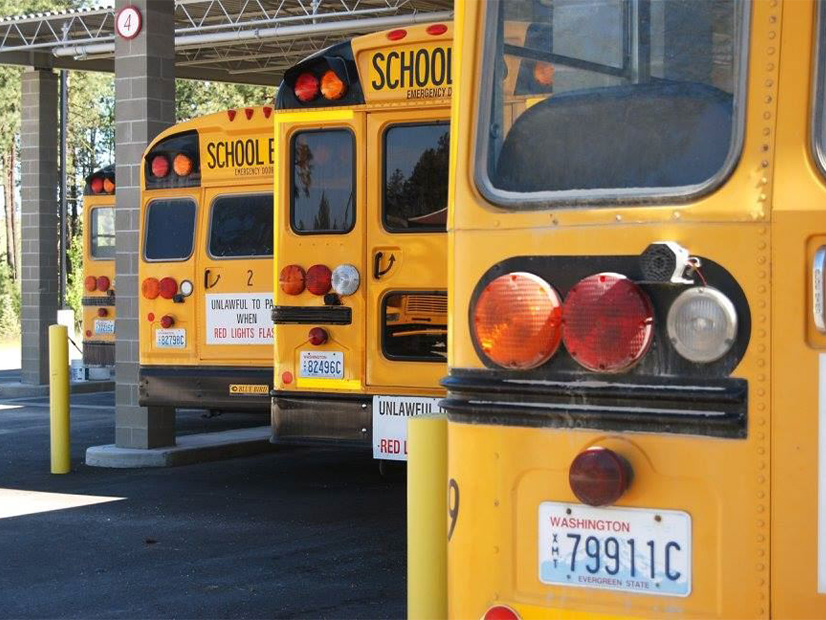
Washington is poised to start phasing in electric school buses after lawmakers approved a bill directing the Department of Ecology to help school districts convert their existing diesel fleets.
Washington is poised to start significantly phasing in electric school buses after lawmakers approved a bill directing the state’s Department of Ecology to manage a program to help school districts convert their diesel fleets.
But that might take decades: Washington has 10,460 school buses, but only 76 are electric.
And the price tag? Still up in the air. Ditto with where the bulk of the money will come from.
The reason for doing this? To cut the pollution getting into kids’ lungs.
“It is as much about healthy kids as it is for the environment. … I understand the anxiety about this big change, but we can’t wait any longer. Our children’s future depends on this,” said Rep. Tana Senn, D-Mercer Island, who introduced House Bill 1368 to foster the switch from diesel to electric school buses.
Washington is following the lead of New York, which has required school districts to purchase only electric buses starting in 2027 and convert their fleets by 2035.
Diesel exhaust hovers around stopped buses, with children more susceptible to the effects because they breathe 50% more air per pound of body weight than adults, according to EPA and the National Institutes of Health. The fumes contain particulates that can lead to asthma and lung cancer. Diesel exhaust from school buses potentially affects one-third of U.S. students, their parents and educators each day.
A Natural Resources Defense Council study concluded that a child riding inside a diesel school bus may be exposed to up to four times the level of diesel exhaust as someone riding in a car ahead of it. Exposure levels were higher in the back of the bus and when windows were closed. The study said children exposed to diesel exhaust while riding in a school bus for one to two hours a day, 180 days a year for 10 years might result in 23 to 46 additional cancer deaths per 1 million children.
“I’m shocked and frustrated. I was exposed to unhealthy fumes just to go and from school,” Sarah Lo, a 17-year-old Seattle student, said at a Feb. 24 hearing on the bill before the Senate Ways and Means Committee.
Relaxed Timetable
The Democratic-controlled Senate on March 7 passed HB 1368 along party lines. The bill will require the Ecology Department to manage grants to school districts to help replace their old diesel buses with electric buses, with funding priority for low-income districts. The districts will be required to buy electric buses when the total cost of owning such buses — which included buying and operating the buses and building the charging infrastructure — drops below the total costs for operating diesel buses. When that parity will be achieved is still an open question.
The bill also requires the Office of Superintendent of Public Instruction to survey the state’s 295 school districts about how to proceed with adopting zero-emission buses.
The House approved the amended bill March 6 along party lines. The main change eliminates a timetable to start a gradual but serious transition in 2027, substituting a more open-ended replacement schedule based on when it makes more financial sense to replace the buses. The expectation is that the total costs of buying and operating an electric bus will shrink over the years, Senn said.
Currently, the average price of an electric school bus is $412,907, compared with $142,154 for a diesel or gas bus, OSPI said in an email to NetZero Insider.
“This is to move it forward if and when we can move it,” Sen. Lisa Wellman (D) said during a March 1 Senate floor vote.
Speaking during the same vote, Sen. Brad Hawkins (R) said, “The state is trying to get its tentacles in [school board business]. … This bill is like the Washington Legislature trying to become the local school board’s transportation director.”
The state budget for fiscal 2024/25 includes $50 million in revenue from the state’s cap-and-invest program to go to economically disadvantaged school districts to immediately begin the transition. “We’re focusing first on those overburdened communities,” Senn said.
‘Easier Said Than Done’
The changes in HB 1368 reflect concerns raised by school districts and OSPI on Feb. 24 as the bill went through the Senate. Several school officials favored the health and environmental benefits but worried about the originally proposed tight timetables, the massive need to install charging equipment and retrain mechanics to handle electric buses, and the challenge of finding all the money needed to accomplish these tasks.
OSPI has not yet determined transition timelines for the revised bill, nor has it calculated overall cost estimates for a long-term, statewide transition.
At the Feb. 24 hearing, Jon Holmen, superintendent of the Lake Washington School District, noted that his school system has more than 130 buses and replaces 10 per year. “Unfortunately, transitioning to electric buses is easier said than done. … We are ready and willing to do the transition, but we can only do so through a partnership and with ample support from the state.”
“We want to make sure it works,” Mike Hoover, a lobbyist for the Washington State School Directors Association, said at the hearing. “We’ve had technologies overpromised before, and we hope this is not another taste of that.”
Paul Marquardt, executive director of operations for the Bethel School District, said a typical bus run in his district is about 80 miles. “We would not be able to complete a run with an electric bus,” he said at the hearing.
OSPI said small buses have an average range of 45-55 miles, while large buses can cover 70-90 miles.
Senn said the legislation allows school districts to keep enough diesel buses to handle routes that are longer than the range of an electric bus. She expects electric bus ranges to increase as the technology improves.

